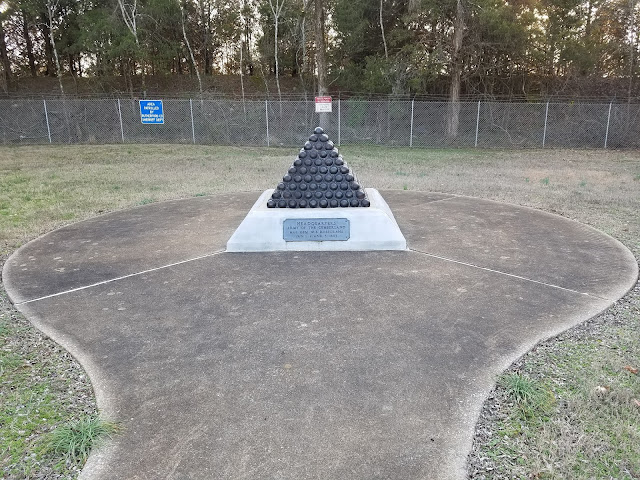Welcome
back to our blog on the National Park Service!
In this post, we will be visiting our first Civil War battlefield,
Stones River National Battlefield in Tennessee.
BACKGROUND:
In
December of 1862, the situation for the United States was dire as Confederate
forces continued to pound the Army of the Potomac into submission in
Virginia. The only glimmer of hope for
the Union was coming from the western theater of war along the Mississippi
River and in Tennessee.
Just
after Christmas, the Union Army of the Cumberland, under the command of General
William Rosecrans, set out from Nashville to seize the strategic town of Murfreesboro
in central Tennessee. The Confederate
Army of Tennessee under General Braxton Bragg was there waiting for them. The two armies faced off against each other
on New Year’s Eve 1862 just west of Stones River, which runs north, parallel to
Murfreesboro.
The
Confederates launched furious assaults on the Union right flank beginning at
dawn. The attacks continued through the
morning until the Union right finally broke, the pulverized units retreating north and reforming
along the Nashville Pike, the main road between Nashville and
Murfreesboro. Here, Union troops put up
a determined stand, beating back multiple waves of Confederate assaults into
late afternoon. By the end of the first
day, the Union army formation which started the day in a roughly straight line
was now bunched into a squished ‘L’ shape along the Nashville Pike
practically surrounded by the Confederates.
 |
| The old Nashville Pike. Union soldiers held along the road while Confederates assaulted from the left |
New
Year’s Day 1863 saw little fighting, but on January 2nd Bragg
ordered a new assault, this time against the Union left flank aimed at troops
Rosecrans had sent to occupy high ground on the eastern side of Stones
River. The Confederates advanced, but
were brutally repulsed by a massive artillery barrage from the main Union line
on the other side of the river.
With
both sides having taken enormous amounts of casualties, Bragg decided to
withdraw rather than continue to futilely attempt to hold Murfreesboro against
Union reinforcements. His decision
turned the battle from a tactical draw into a strategic Union victory.
 |
| Cannon placed at the site where Union artillery repulsed the Confederate attack on January 2nd |
Following
the capture of Murfreesboro, Rosecrans set about turning the town into a major
supply depot for the Union’s future campaign to take the vital railroad hub of
Chattanooga. To this end he built a
massive fortress, named after himself, that was virtually impregnable, to guard
his supply lines at Murfreesboro.
A
section of the battlefield was established as a unit of the National Park Service
in 1927.
THE BATTLEFIELD:
Stones
River National Battlefield is located in Murfreesboro, Tennessee. Of the entire area over which the battle took
place, only a relatively small part is preserved by the National Park Service,
the rest having been covered by urban sprawl.
The battlefield lies in three sections, the first is bordered to the
north by the old Nashville Pike where the Union troops made their stand on
December 31st, still in use though no longer a major road, and stretches
in a rectangular shape about a mile to the south. It is in this area where the heaviest
fighting took place. This portion of the
battlefield contains several trails for visitors to follow the events of the
battle.
 |
| A long view of the battlefield from the perspective of advancing Confederates. The visitor center and old Nashville Pike are in the distance |
On
the north side of the Nashville Pike is Stones River National Cemetery and
the Hazen Brigade Monument. Following
the end of the Civil War, the Union soldiers killed during the battle were
reinterred, the cemetery now protected by the park. The Hazen Brigade Monument was erected only
months after the battle by soldiers of Colonel William Hazen’s brigade who held
the ‘corner’ of the Union army’s ‘L’ shaped formation against Confederate
attacks, a location dubbed by veterans as “Hell’s Half Acre.”
 |
| The Hazen Brigade Monument at "Hell's Half Acre" |
To
the north, across the CSX Railroad tracks and Route 41 is the McFadden Farm
section of the battlefield, where the Union artillery was placed that beat back
the Confederate assault on January 2nd.
The
third section of the park is much closer to the center of Murfreesboro and
preserves the last remnants of Fortress Rosecrans, the massive earthwork fort
built by General Rosecrans to secure his supply lines. Only the southern corner of the fortress, the
earthworks known as Lunette Palmer and Lunette Thomas, remain.
TRAVEL TIPS:
Stones
River National Battlefield, both the main battlefield and the two smaller
sections, are easily accessible despite the urban area of Murfreesboro. The visitor center is located at the main
section of the battlefield along the old Nashville Turnpike. The visitor center includes a short film and
artifacts from the battle. The park
brochure provides a route for a driving tour of the main battlefield
locations. The site is mostly
handicapped accessible, and the passport stamp is located at the visitor center. Those who wish to have a more “authentic”
experience of conditions during the battle are recommended to come in the
winter.
We
hope you enjoyed this brief summary of Stones River National Battlefield. In our next installment, we will be heading
back up to Massachusetts to New Bedford Whaling National Historical Park.
ADDITIONAL PHOTOS:
 |
| Medal of Honor awarded to Union Private Joseph Prentice for his actions at Stones River, on display in the visitor center |
 |
| Monument marking the location of General Rosecrans headquarters during the battle |
 |
| Monument to the Union artillery at the McFadden Farm |
 |
| Stones River National Cemetery |



No comments:
Post a Comment